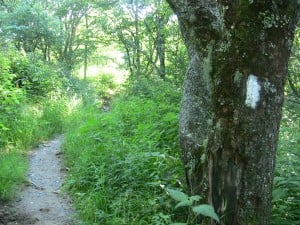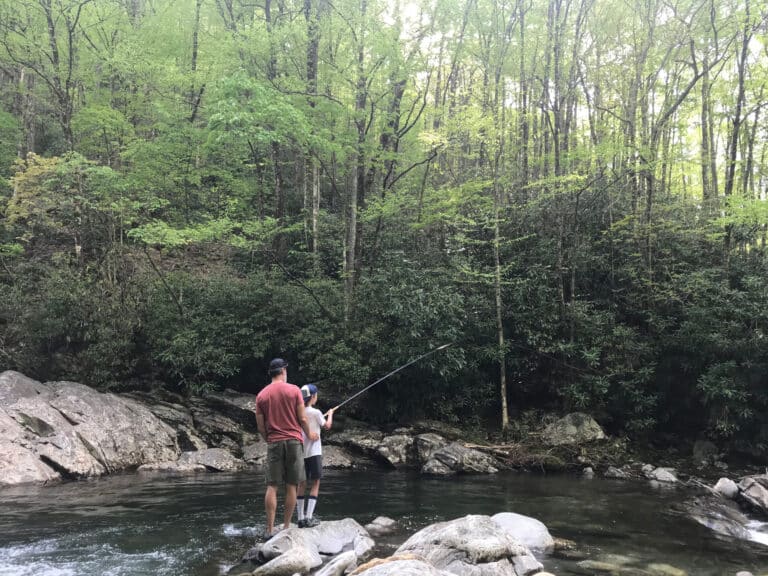

Yesterday, I completed a 72-mile, end-to-end run across Great Smoky Mountains National Park in just under 17 hours, a speed record. However, the real goal was to help bring an end to the devastating and deadly effects of mountaintop removal mining.
I followed the Appalachian Trail (A.T.) for the entire run. The Smokies section of the A.T. is one of the toughest trails in the country: the steep, boulder-strewn footpath climbs sharply up 6,000-foot summits, including an ascent of Clingmans Dome, the highest mountain on the A.T.
But the trail’s difficulty is surpassed by its beauty: it abounds with lush old-growth forests, dramatic vistas, and an unsurpassed array of wildlife—especially bears. An estimated 1,500 black bears reside in Great Smoky Mountains National Park.
I had attempted a Smokies end-to-end run six years ago and barely survived. A pollution-induced asthma attack during the run stranded me on the trail. Ironically, my run was intended to promote clean air, but the orange-alert ozone day in the Smokies that summer day had constricted my chest and airways, leaving me wheezing and unable to walk 10 feet without stopping to catch my breath. By nightfall, I had stumbled across an open bald before nearly colliding with a bear in the moonless, dark night. Without a headlamp, I used the glow light of my watch to read a trail sign pointing the way to Spence Field shelter, where I was able to get water and rest. By morning, pollution levels in the park had fallen and my breathing had recovered, and I was able to finish the run.
But my wife suffered even more than I had on that run. She had hiked in to meet me at a shelter along the trail to provide food, water, and a headlamp, but when I did not arrive that night, she feared the worst. She spent a sleepless night at the shelter, where she was visited by a large bear, wondering whether I was lost, mauled, or dead. We tearfully reunited at Fontana the next morning, but the pollution-induced respiratory attack had profoundly shaken me.
However, I wasn’t going to let coal-fired power plant pollution keep me away from the Smokies forever. Six years later, I decided to return for another end-to-end run. This time, I was running to help bring an end to mountaintop removal mining, in which coal companies blow up Appalachian mountains and dump the toxic debris into adjacent streams. Cancers and diseases are rampant in mountaintop removal areas. Dozens of mountain communities have been destroyed, 1,200 miles of rivers have been buried and poisoned, and 470 mountains have been beheaded. Another five proposed mountaintop removal sites are within 50 miles of Great Smoky Mountains National Park.
On June 25, 2009, I began my run across the Smokies to end mountaintop removal. Just two days earlier, Daryl Hannah, NASA scientist Dr. James Hansen, and dozens of other activists were arrested at a mountaintop removal protest. I hoped my journey could educate visitors to the most visited—and most polluted—national park in the country about the devastating health impacts of mountaintop removal.
My friend, Chris Weller, dropped me off at Davenport Gap on the eastern edge of the Smokies at 5am. In the dark, I carried a small flashlight to guide me up the muddy trail towards Mount Cammerer. I also had a fanny pack with two water bottles and a third hand-held bottle, since I would be on my own for most of the day and temperatures were expected to climb quickly into the high 80s.
By mile 3, I felt blisters forming on my heels. I couldn’t believe it. My feet rarely blister, but I was wearing relatively new shoes, and I had kicked a lot of grit from the wet, muddy trail into the heels of the shoes. I was also hiking steeply, and the sharp angle of my feet in the shoes also may have encouraged the blisters to form. Regardless, I was pretty frustrated.
To keep my mind off the pain of the blisters—and the thought of 70+ miles with blistered heels—I sang children’s songs. My one-year-old son River was on my mind, so I sang one of his favorites, “Peace Like a River,” all the way to Cammerer. Keeping a peaceful, fluid running form—and attitude—would be critical to reaching the finish, so I kept the musical mantra in my mind all day.
The blisters worsened as they broke open and rubbed raw, but I kept focused on the beauty around me, especially the lush forests and cool breezes rolling off 6,000-foot Mount Guyot. I soon reached Tri-Corner Knob and refilled my water bottles at a trailside spring. My good friends Mark and Anne Lundblad had encountered a large bear at Tri Corner Knob just a few weeks earlier, so I said a quick prayer of thanks to the bears and other creatures who were allowing me to pass through their home.
The blisters were less painful on downhills, so I sailed briskly down to Pecks Corner and again refilled water bottles. From here began a long waterless stretch across a narrow ridgeline—called the Sawteeth because the thin jagged ridge dropped precipitously on either side. I soaked in the incredible views of North Carolina to the left and Tennessee to the right, with the narrow, briar-choked trail straddling the state line.
The sun was blazing high in the sky now, so I pulled out my hat and dug in for several climbs up to Icewater Spring, then danced down the boulder-lined trail into Newfound Gap.
It had taken me 7 hours, 10 minutes to reach Newfound Gap. Chris was waiting in the parking lot wearing his END MOUNTAINTOP REMOVAL t-shirt and distributing information to the hundreds of hikers congregated there. I refueled quickly and left Newfound Gap five minutes later, eager to tackle one of the toughest climbs of the day—the eight-mile trek to Clingmans Dome.
My blisters had been pounded into an uncomfortably numb state. I was reminded of their presence with each step, but I was not debilitated by the pain. I kept a steady pace in the midday heat, careful not to overexert myself and trigger a respiratory attack. On this hot summer day, pollution levels were again expected to reach a code orange alert. This time, I was taking ibuprofen to help keep reduce bronchial inflammation and keep my airways open.
Two hours later, I arrived atop Clingmans Dome and eagerly plunged down the back side. I felt a renewed vigor as I slalomed down to Double Spring Shelter and summited Silers Bald. But soon the mid-afternoon sun and heat took its toll, and by the time I began the approach to Thunderhead Mountain, my pace began to slow. The ascent of Thunderhead featured the steepest, rockiest climbs of the entire trail, including a few sections where I used all-fours to scramble up. The descents were equally sharp, with jagged boulders poking out of the trail. I clambered up numerous false summits, only to see the dark shadow of Thunderhead high in the distance.
I had failed to refill my third water bottle at Derrick Knob Shelter, so I soon ran out of water on the climb to Thunderhead. When I finally reached the wooden sign at its summit, I had another couple of miles across overgrown, deeply rutted, ankle snapping trail to Rocky Top and then Spence Field. The sun baked the exposed, open balds, slaking my thirst and reducing my pace to a trudge. And my chest was tightening and my breathing was getting shallow.
I finally hopped down the water-bar lined trail and arrived at Spence Field, where Chris had hiked in to meet me with food, water, and a headlamp. I checked my watch: 6:30pm. I still had 17 miles to go, and only two more hours of daylight. I forced myself to eat a muffin and some strawberries before dragging my body back onto the trail. I was hot, hungry, nauseated, oxygen-deprived, and dispirited.
Then I saw the sign…the Spence Field Shelter sign I had read by watch-light that probably saved my life six years ago. Suddenly all of the emotion from that experience came flooding back. I picked up my pace on the dirt-packed downhill to Russell Field Shelter, where my wife had been stranded. Soon I was flying toward Mollie’s Ridge. I was pouring everything I had into running fast, smooth, and peaceful, like a river. I wanted to cover as many miles as possible before dark, so I pushed myself up Mollie’s Ridge and then Doe Knob. But I had run out of water again, and still had 7 miles to go. I made it to Birch Spring a few miles later and could hear a wheezing in my throat as I scampered down a side trail to refill my water bottles one last time.
It was completely dark now. I strapped on my headlamp, whose beam was not very strong, so I ended up holding it my hand for the final five miles. A few sneaky hills still remained, including a steep ascent up to Shuckstack. My legs were badly beaten up from the fast pace, but I slung my body up Shuckstack and began the screaming four mile descent to Fontana. I could barely see the trail with my faint headlamp, and I was moving as nimbly as I could over rocks and roots on the sharply turning trail. My quads and knees were getting pounded by the fast pace. My blistered feet were on fire. I checked my watch and saw that a sub-17 hour finish was possible. But I could not go any faster with the limited vision I had. One time, I let my body accelerate on a steep downhill only to fly off the side of the trail and crash into a briar patch; another time, I opened up my stride a bit and started really flying, only to stumble down a sudden drop in the trail and nearly face-plant into a boulder. I could see the lights of Fontana Dam, but the punishing trail continued to snake down the ridge in a seemingly endless series of switchbacks.
There were several blowdowns in the final two miles, including a giant tree with all its leaves and branches blocking the trail for about 50 feet. I slashed through the tangle of limbs, but could not find the trail on the other side. I continued to wrestle through the branches, searching for the trail, which had twisted sharply above me. I clambered back onto to the trail continued pounding downhill.
Finally the trail spit me out onto the paved road leading to Fontana. After several miles of bracing down the dark downhills, I opened up my stride and let it rip. The lights of Fontana Dam glowed through the trees and glistened off the lake. I poured everything I had left into the final stretch and finished in 16 hours, 53 minutes. I found out later that my time had tied the speed record; Knoxville elite runner Bob Adams ran exactly the same time just a few months earlier this year.
Afterward, I lay on the concrete beside the visitor center and listened the sound of the water pouring over the dam. A sliver of moon hung over the lake. I soaked up the starlight and the silhouette of the mountains.
Just a few miles away, mountains as beautiful as these were being dynamited and dumped, poisoning the communities that live near these operations—just to get at the last remaining seams of coal. My 72-mile run would probably do nothing to stop more mountains from being beheaded and more people from dying. I never felt so small. And at the same time, in the shadows of ancient mountains, I never felt more inspired to keep fighting.
To learn more about mountaintop removal mining and your connection to it, visit ilovemountains.org.
For additional information about the Smokies End-to-End Run, visit milesformountains.org.






